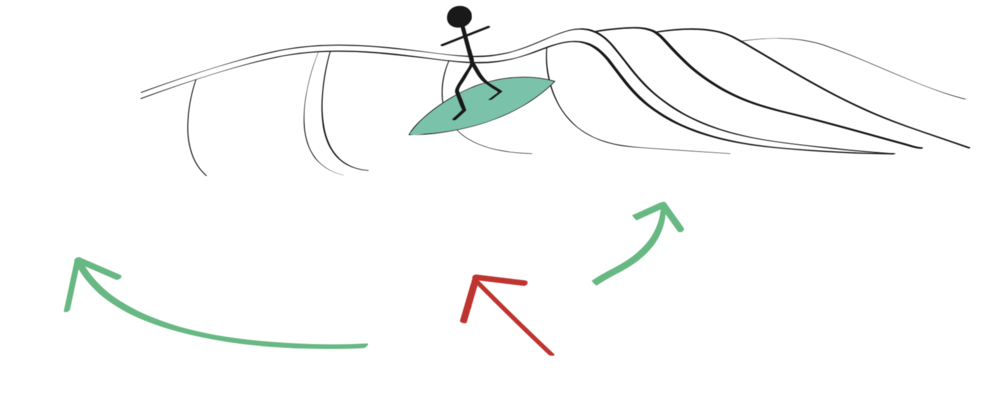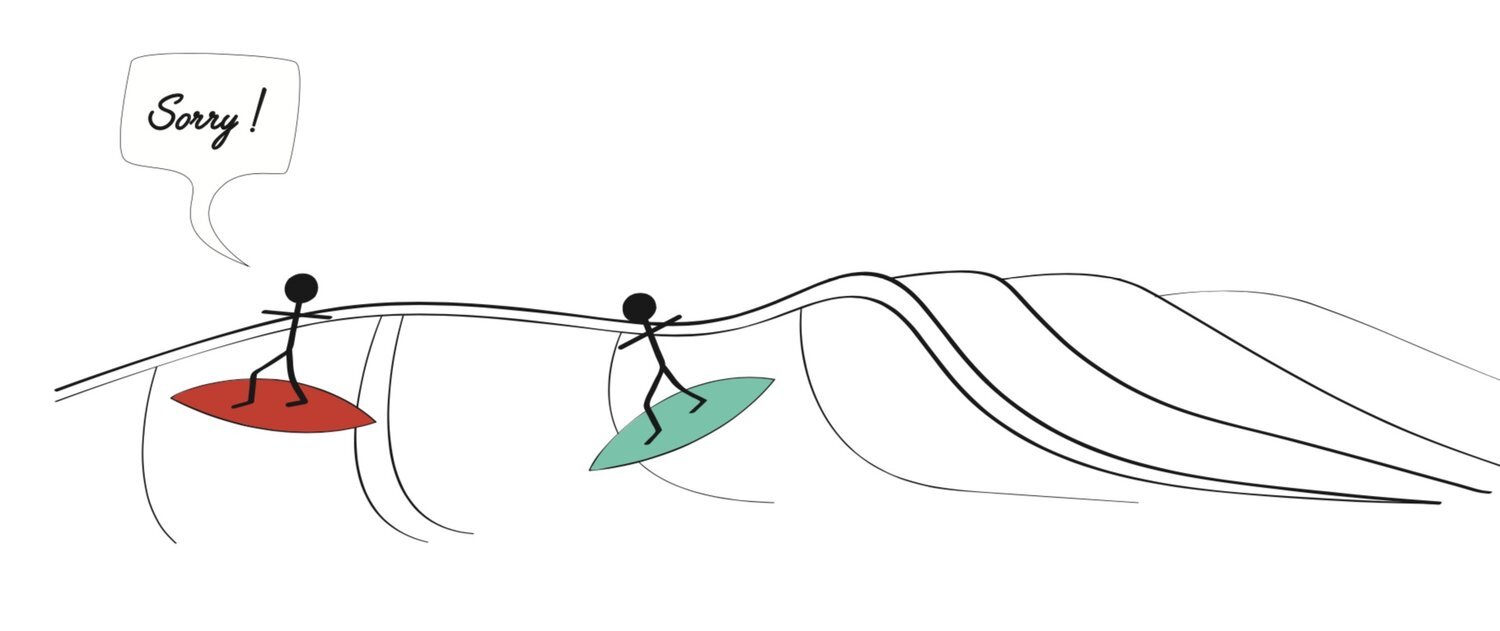SURF ETIQUETTE AND SLANG
Surfing is not only about having fun, safety and surf etiquette is also an very important part. Are you new to surfing? Or you have had some surf lessons already or visited a surf camp? But you can’t remember every detail and you are still confused about the surf slang. We are here to help.
SURF ETIQUETTE
Rule 1: Safety first and never throw your board
If you kick out or if there is a wave coming towards you, you have to either duck dive or turtle roll. Always be aware of your surroundings and where you have your board. Surfboards can cause big damages on other surfboards or they can actually kill someone if they hit critical areas of the body.
If you want to paddle out in any line up, you must learn to control your surfboard all the times. Also make sure that you never paddle out directly in front of or behind another surfer. Try paddling out next to them, or give yourself at least enough safety distance.
Rule 2: Don’t get in the way
When paddling out to the line up, go around the break not through it. Stay clear of surfers on the wave.
A surfer who is already on the wave has always the right to go down the line. If you are in front always paddle towards the whitewash. If caught on the inside catch the white water.
Rule 3: The surfer closest to the peak has the right of way
The surfer closest to the breaking wave has the right to surf the wave
Do not drop in! If someone is about to drop in on you make yourself heard.
As a longboarder, we all know you can catch almost every wave, but sharing is caring and please leave some waves for the shortboarders.
Rule 4: Don’t be a snake
Never paddle around or cut in front of another surfer and take possession of the wave.
Better to choose the best position in the line up and wait for your turn. There is a wave for everyone.
Rule 5: Don’t drop in
Don’t do to others what you don’t want done with you. Make sure you look both ways before dropping in every time you paddle for a wave.
If you accidentally drop in on someone, try to kick out of the wave as quickly as possible. If you lack board control, do your best to angle your surfboard towards and off of the shoulder of the wave. Don’t simply fall off of your surfboard as your board could run into the surfer riding the wave. Make sure to immediately apologize to the person you just dropped in on.
Rule 6: Communicate
Both surfers may surf from one peak if there is the possibility to go in opposite directions. Communicate your direction to avoid accidents.
Rule 7: Know your limits
Don’t go out in big waves until you are ready. Observe surf conditions and line up and determine your place after ability. Also be careful during a wipeout, always protect your head and fall flat.
SURF SLANG
“closeout” – a wave or a large section of a wave that breaks at the same time, making it impossible to continue surfing the open face of the wave
“deep” – the steepest part of the shoulder closest to the peak of the wave is considered the deepest part of the wave. Often when a surfer is “too deep” they are unable to drop in to a wave without falling off of their board
“down the line” – along the face of the wave
“drop in” – to steal a wave of someone else by dropping in on the wave in front of the other surfer who is already riding the wave
“duck dive” – a technique used to paddle out past a breaking wave. Arms push the nose of the surfboard down while the knee or foot pushes down on the tail as the surfer dips below the passing wave
“face” – the open, unbroken part of a wave
“goofy” – right foot in front, left foot at the back
“green wave” – an unbroken wave, allowing the surfer to surf along the face of the wave, going either left or right parallel with the beach instead of straight towards the beach
“impact zone” – where a wave first brakes
“inside” – when paddling for a wave, “inside” refers to the person closest to the peak of the wave. “Inside” also refers to the shallower part of the water closest to shore or means the part between shore and the breaking wave
“kick out” – to surf out of the wave, ending your ride (also called flicking out)
“lineup” – the area where the waves normally begin breaking. Surfers sit on their boards in the lineup, que up and wait for waves to break.
“longboard” – a longer, wider, thicker surfboard. Longboards catch waves much easier than shortboards but are harder to control and turn.
“left” – a left is a wave that is breaking to the left. The direction “left” is used by the surfer when describing the direction of the wave while facing the shore. Therefore, from the beach, a “left” is described as a wave that breaks from left to right.
“offshore” – wind blowing from shore onto the ocean
“outside” – when paddling for a wave, “outside” refers to the person further away from the peak of the wave. “Outside” also refers to the deeper part of the water, where the biggest waves break, further from shore.
“peak” – the immediately breaking part of the wave.
“regular” – right foot in front, left foot in the back
“right” – a right is a wave that is breaking to the right. The direction “right” is used by the surfer when describing the direction of the wave while facing shore. Therefore, from the beach, a “right” is described as a wave that breaks from right to left.
“section” – a part of a wave. When a surfer “makes a section” a surfer is staying in front of a breaking section of the wave.
“set wave” – a larger wave (the largest waves usually break in sets of 2,3, or 4)
“shortboard” – a shorter, narrower, thinner surfboard. It is more difficult to catch a wave on a shortboard than it is on a longboard, but a shortboard can be controlled/turned much easier.
“shoulder” – the unbroken section of the wave directly next to the peak
“snaking” – stealing a wave out of turn by paddling around other surfers
“turtle roll” – a technique used to paddle a longboard out past a breaking wave. Longboards are generally too big to duck dive. With the turtle roll technique the surfer turns upside-down and propels the surfboard (also upside down) through the breaking wave.
“whitewash” – the broken white water of a wave moving straight towards shore
“wipeout” – when a surfer falls from his board







